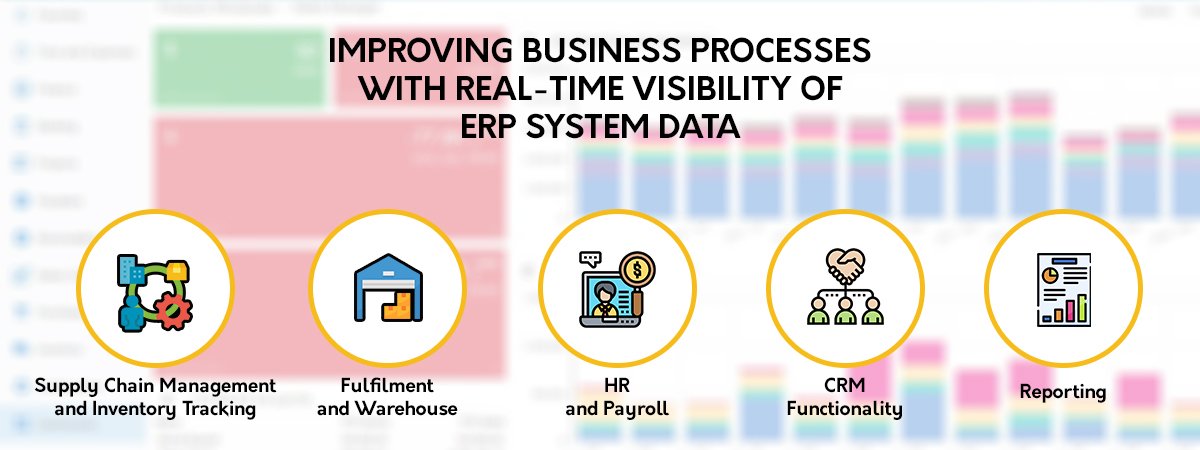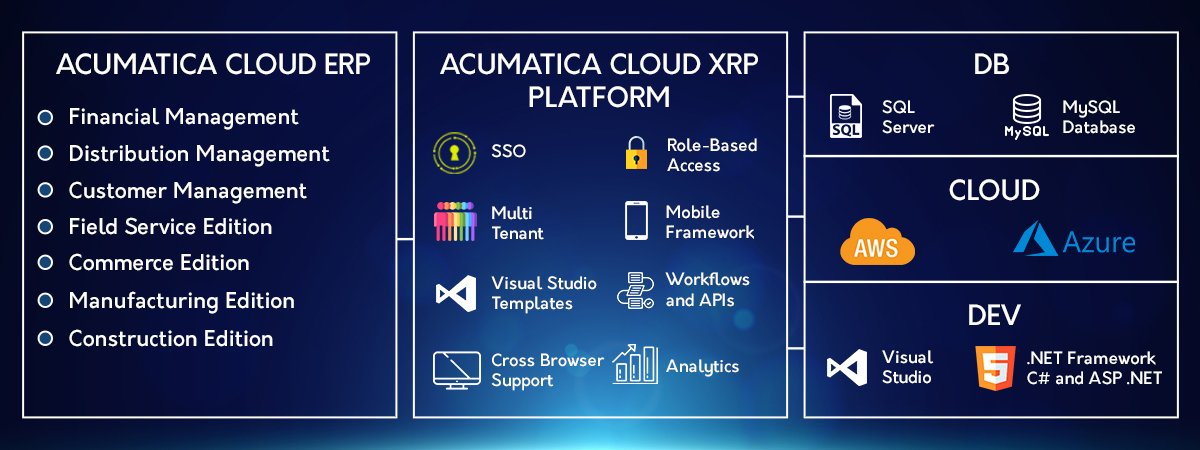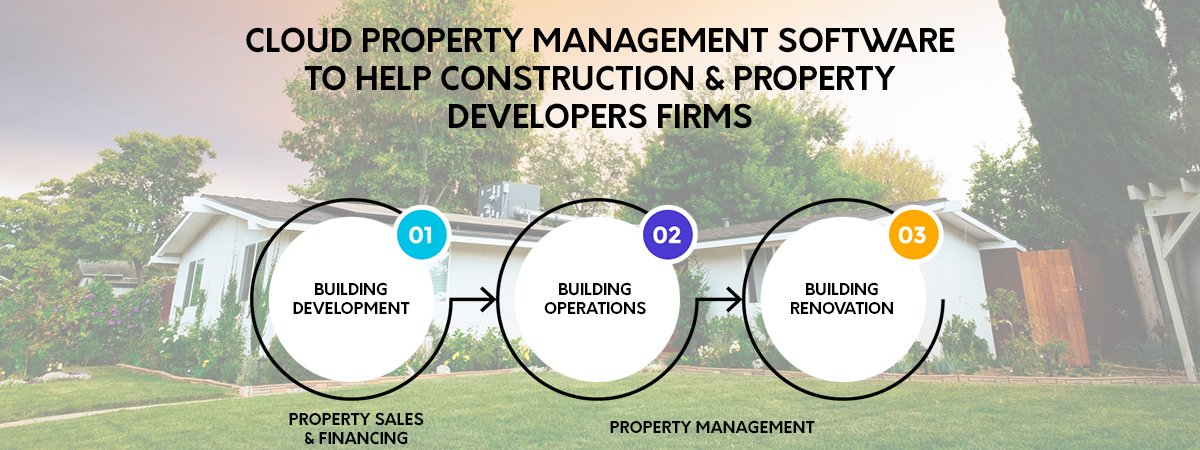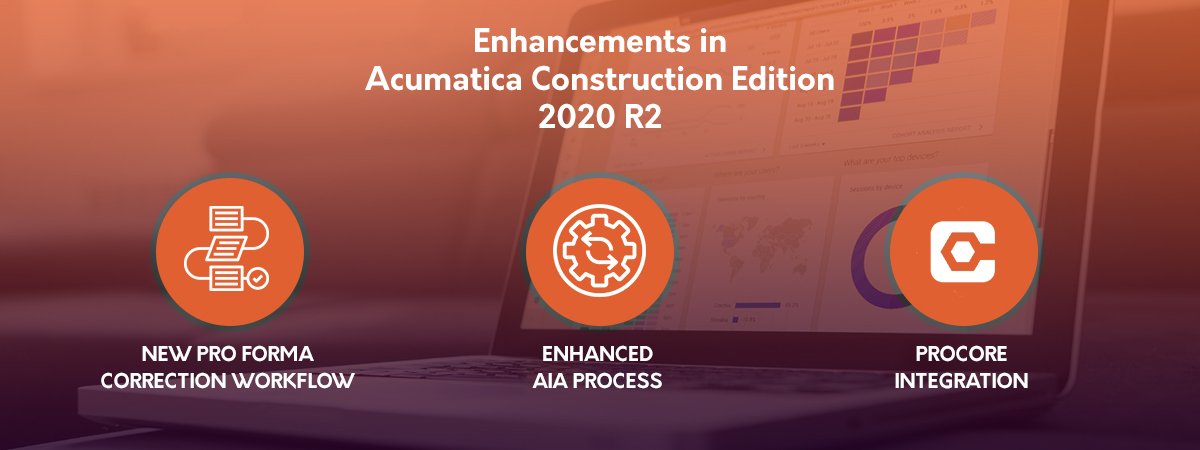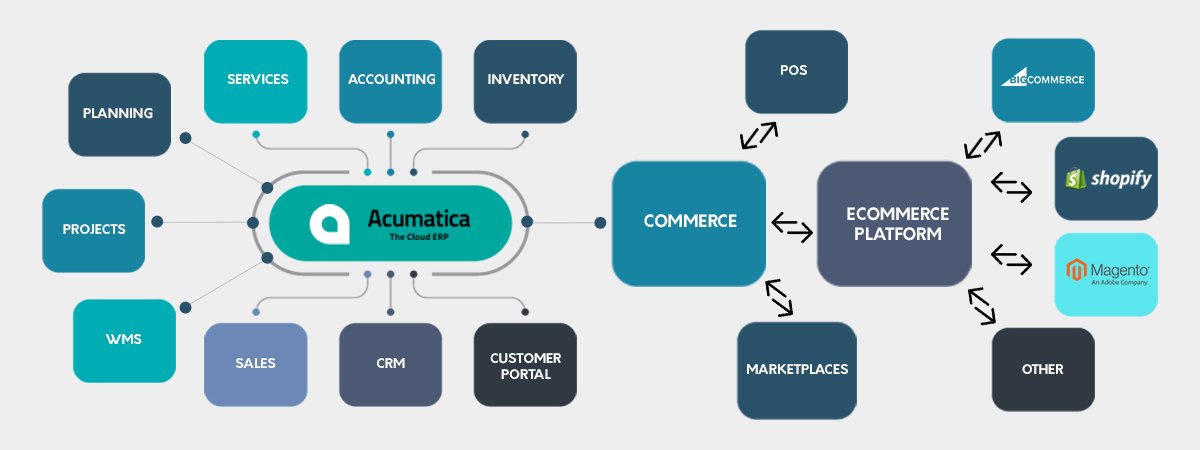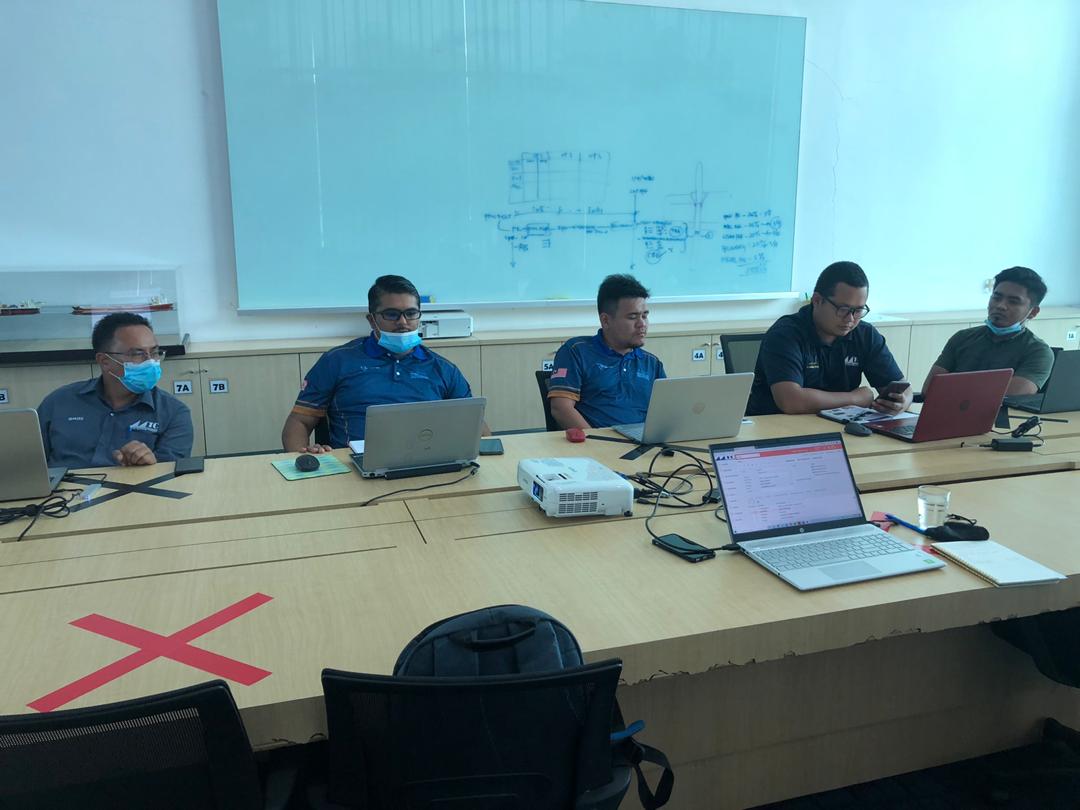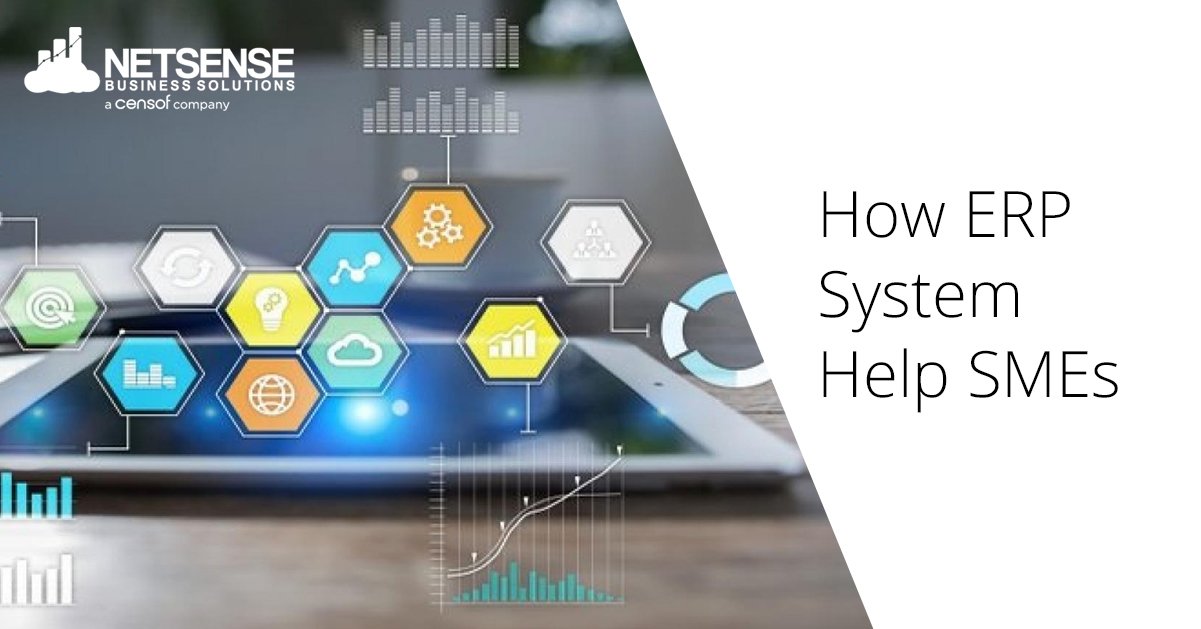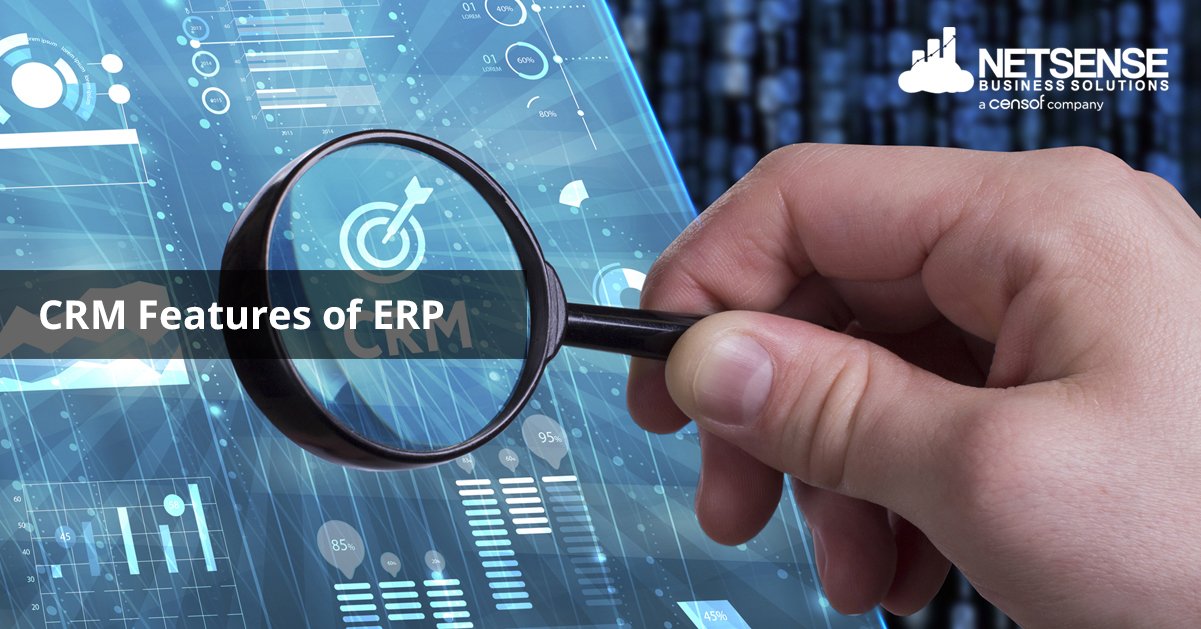With consumers’ increased demand for a high level of visibility into product status throughout the transaction, companies couldn’t overlook a suitable data collection technology to determine what’s in stock, what’s being produced, what they need to re-consider. They can no longer rely on manual efforts or scattered spreadsheets to gain visibility into business insights, otherwise, it will lead to more labour costs, project delays, excess inventory, and human errors. No matter whether you’re a manufacturer, distributor, or property manager, you have to see what’s happening within your organisation to make a good shot at effectiveness and profitability. Despite knowing the value of real-time information, many SMEs still unsure what they need or where to begin. With advances in cloud and computing power in Enterprise Resource Planning (ERP) system, companies can increase visibility in all departments to track performance and results of specific processes and goals. How Lack of Visibility Can Hurt Your Business? The recent Zebra Technologies study reveals that almost 40% of companies are still not using mobile computers or mobile barcode scanners. Without real-time barcode scanning and data accumulation, managing inventory could be a challenging task, which may lead to mistakes and have a negative impact across the entire business. Therefore, you shouldn’t stack applications on to accounting systems and then export data into several spreadsheets to figure out what’s happening. Here are some problems that can be caused due to lack of visibility: Data entry errors – Manual data transactions often lead to errors, which further creates inventory inaccuracies and shipment errors that can be tricky to detect. Unnecessary labour costs – Without barcode scanners, you need to invest a lot of time typing data into computers and inspection is necessary to fulfil the order. Excess inventory – Inaccuracy of inventory data can lead to unnecessary purchases and high inventory expenses, which can cut into profitability. Delay in decision making – Without useful insights, you cannot keep your teams informed and updates, which holds users back from making smart and more informed decisions. How does Cloud ERP System Help Companies Improve Visibility? With a cloud-based ERP solution, you will receive a tool that enables you to build knowledge and vision directly within a single database, eliminating the strain of synchronising disparate systems and information. The integrated data provides you with real-time visibility, making sure that you are focused on making the right decisions in the right area. Supply Chain Management and Inventory Tracking The ERP system gives you real-time visibility into several warehouses and entities – all the information available at your fingertips. This way, you will gain a clear picture of where everything is, what’s in transit, and which products are stored on trucks, and other key pieces of information. Fulfilment and Warehouse The ERP solution allows users to see the entire supply chain, right from the acquisition of products to customer delivery to help understand actual and projected sales. With accurate and timely information, you can streamline, automate, and meet your customer relationship goals more effectively. You can anticipate challenges and overcome them early to exceed your future needs. HR and Payroll When you have two functions integrated into a single software, HR and payroll processes can run automatically which reduces the risk of errors or keep it to a minimum. A manager will simply receive a time-off request that can be immediately processed through the system and sent to the key employees. CRM Functionality The integrated ERP with efficient CRM can help strengthen business processes like sales, returns, payments, billing, and budget. It not only streamlines workflows but also improves customer relationships. Reporting Every organisation works on a variety of reports that should be generated and shared on a consistent basis. Instead of struggling with thousands of spreadsheets, using an ERP solution can help to generate reports in a clear and comprehensive format. How Netsense Can Help to Transform your Business Processes? At Netsense, we never take our clients’ needs for granted and are consistently working to deliver best-in-class features and functionality in our ERP solutions. We deliver a scalable Acumatica ERP system with a number of product suites like project accounting, smarter integration, cloud-based, and mobile resource management tools that bring changes in real-time. This way, you can effectively manage complex projects, enhance reporting, and exchange data in real-time across all departments within the organisation. If you have any queries about the Acumatica ERP solution, you can connect with our experts and also request a demonstration to attain a clear understanding. We assure you, it will be a time worth investing.
To thrive in a competitive and complex business environment, companies and leaders need to put a technologically advanced system in place that allows them to streamline, automate, and scale. From minute details to major change, one mistake could cut down the profits, strain customer and partner relationships, and ruin your company’s reputation. With every cloud ERP vendor attracting buyers’ attention by promising the best solution, it can be daunting to select the suitable one. Suppose, when something is broken or damaged, you turn to the repairing expert likewise, you should look for the experts that offer best-in-class features and functionality in one solution. That’s why, many users support the appeal of industry-specific ERP, providing necessary modules for a company’s specific industry that reduces time, cost, and risk. Why Industry-Specific ERP Solution Matters? Selecting and implementing cloud ERP software is a crucial and long-term decision. It takes a significant amount of time and effort to pick amongst a plethora of choices available in the market. It is always ideal to rely on a solution that serves your industry in the best possible manner while having the flexibility you need as your business grows. Industry-specific ERP is tailored to meet or exceed the needs of a particular industry. Just as you count on a highly trained mechanic to modify your car, you can simply use a full-fledged solution to run business processes smoothly, including distribution, field service, production, commerce, and construction. A cloud-based industry-specific ERP system is built with the exact features and capabilities you need to achieve success in your niche market. Which is Better – Industry-Specific ERP or Generic ERP? Industry-specific ERP solutions generally have better applicable functionality as they are built around definite needs with a clear understanding of industry processes. If we talk about ‘one-size-fits-all,’ Generic ERP comes first into the mind, offering resources for product development which may or may not fit perfectly for industry-specific users. In addition, it requires some sort of customisation, add-ons, and enhancements to meet the precise business needs to gain a competitive edge. Well, these customisations can be an expensive and time-consuming affair, as well as it barely does the job and adapts to the environment when processes or technologies evolve. This is why the Acumatica ERP system offers the best of both the worlds that can serve industry-specific or generic functionality depending on business needs with core features and user-friendly cloud technology. By fully embracing the flexibility of the ERP system, you don’t need to choose between industry-specific and generic functionality. Acumatica ERP being the cloud-based system, offers industry editions to fulfil industry-specific standards and support powerful practices without compromising on mobility, integrations, and data transparency. Why Choosing from Acumatica Industry-Specific Edition is a Viable Option? Is your existing generic ERP solution couldn’t connect well with financials? Do you need a reliable platform to create new product landing pages? You can solve such issues by moving to the Acumatica ERP system that is tailored to meet or exceed to fit your best interest with a deep understanding of ins and outs of your industry. At Netsense, we offer Acumatica ERP Industry Editions, including Distribution, Manufacturing, Field Service, Construction, Retail and E-commerce, and more to eliminate the burden of keeping up with industry standards and regulations. We continue to bring user-friendly ERP solution to offer superior usability, smart industry-specific solutions, and advanced business capabilities that enhance efficiency and profitability. Whether you’re planning to outgrow your current software or looking for something more suitable for your business processes and needs, we ensure to provide you with genuine advice to ease your ERP implementation journey. We invite you to see a demonstration of our ERP solution to learn more about its functionality and modules. Are you ready to take the next step? Contact us today to reach ultimate success!
Training Session in Progress : Preparing for Go Live on 1st OctERP Chosen : #Acumatica Cloud ERPClient Industry : Trading & Distribution (Construction materials)Company Size : 70 EmployeesSystem Replaced : Autocount & MYOB#erpsystem #digitaltransformation #smebusiness
Property managers, property developers or real estate owners, be it commercial or residential faces several challenges in fabricating materials, managing complex projects, and keeping the workforce on the same page. The construction industry is booming significantly and one contributing element is indeed cloud-based technology. While the construction & Property development industry seems fast to use advances in processes, some professionals are slow to integrate scalable technology into their applications. Just as a second story can’t be incorporated in the property unless the foundation is strong enough to support the weigh and access, similarly, you cannot expect unique functionality in standalone systems. As the majority of ERP vendors entering the cloud ERP market, Acumatica ERP made a successful move to cloud property management software to help construction & property developers firms gain competitive advantage. The core of the Acumatica ERP is based on several modules like finance and accounting, which property managers and teams can operate with a single dashboard to view and edit accounting reports, CRM, work order management, and much more. Ready to learn more? Let’s dive in! How Property Management Solution Tackles Challenges of Property developers ? Construction companies & Developers are typically stuck in manual-intensive reporting, scattered spreadsheets, and data silos. But thankfully, all such tedious tasks are gradually falling behind with modern and scalable ERP solutions. Acumatica cloud-based property management solution is built to help property managers improve operational efficiency and overall bottom line. Acumatica & Infosoft (Acumatica ISV Partner) has made the solution more technologically advanced and fast-forward with world-class functionality and support. Netsense has partnered with Infosoft to implement Module “RED” (Real Estate Dimension) in Malaysia and Singapore. Here’s how cloud-based ERP can help real estate organisations overcome challenges: Work order management is enhanced through automation capabilities such as eDocument creation for leases and contracts. Manage Sales Booking and Loan process for new property bookings Manage Discounts and vacancy rates Being built on cloud technology means all relevant information is stored in the cloud that users can access and gain useful insights from anywhere at any time. A cloud-based ERP system offers flexible billing options which prove to be very useful if you deal with a variety of packages for multiple tenants. It has made customer service and support much easier with separate web portals for vendors, leaseholders, and partners. Lease renewal and vacancy ratio challenges become a lot simpler as vacancy management combined with renewals. How the Acumatica ERP System is at the forefront of Technological Advancement? Users can trace the proven success of Acumatica from the development of the xRP platform, the fundamental technology that powers cloud-based ERP software. Infosoft introduced a new module “RED” built within Acumatica for Property Developers. “Customers who want to stay competitive need flexible, responsive technology to execute their long-term business strategies. Our ACA label is built to help customers find applications capable of delivering that,” says Vice President of Partner Solutions at Acumatica. Back then, the usage of computers in real estate workflows was virtually non-existent. Since then, the technology has significantly evolved and throughout this revolutionary wave, Acumatica ERP solution continues to grow in three key areas i.e. project management software, cloud ERP and managed IT services. Key Features of Property Management Solution Flexible tenant billing options Highly diversified collection management Tracking and traffic analysis Lease renewal and vacancy management reporting Work orders management Automated workflows and recoveries Utility billing Tenant service billing User-defined and programmed lease abstracts Property and tenant timely reminders Seamless integration with industry-leading financial modelling software And many more How Netsense can Help Streamline Processes of Real Estate Organisations? At Netsense, we are a trusted leader in this niche and has been bringing the highest quality Acumatica ERP solution for both commercial and residential real estate owners, operators, managers. We are offering a fully integrated, future-centric, and customer-focused system to help our clients keep up with current trends and gain a competitive edge over others. Our ERP solutions are filled with optimum capabilities, ideal for leasing, vacancy management, contracts, amenities, property features, and much more. Through this, property managers can streamline and automate their workflows, offering them more time and flexibility to add value to their business to flourish today and in the future. For more clarity about our Acumatica ERP solution for real estate organisations, you can schedule a demonstration with our experts and see the advanced system in action. For further queries and assistance, call us today!
There is no denying that the construction industry can face reduced productivity due to lack of collaboration, inefficient project planning and estimation, resistance to digitalisation, lack of transparency, and time overruns. With global competition and increasing administrative needs, contractors are pushing themselves to incorporate advanced business solutions to simplify complex projects and see a clear picture of future growth. Using technology to synchronise and monitor business processes is nothing new in construction companies. Here’s the good news, now Acumatica 2020 R2 is available, allowing contractors, land developers, and builders to set up for success with superior, simplified user experience. It aims to provide users with a modern, updated design with best-in-class functionality that saves time and ensures the entire construction project cycle runs smoothly and efficiently. How Acumatica Construction Edition 2020 R2 is Suitable for Construction Companies? The final goal of any construction company is to meet or exceed the clients’ expectations while generating maximum revenue to make a great shot at success. Acumatica Construction Edition is built on three pillars of true cloud, high value, and real-time, increasing productivity and helping companies to work smarter, not harder. Acumatica ERP system is designed on the cloud which allows users to obtain seamless integration with every suite, including financial management, CRM, inventory management, production, and field service management. With real-time visibility into insights, all the departments always stay informed, updated, and ready to implement an innovative strategy. Here are some enhancements you will find in Acumatica Construction Edition 2020 R2: New Pro Forma Correction Workflow Companies don’t need to rely on manual efforts anymore. You can simply improve billing cycle efficiency without AR invoices or manual reversing before billing. You can use multiple methods to correct pro forma and receivable invoices, including entering a credit on the next invoice, revise the previous billing without removing the AR invoice, or adjust retainage using credit memos. Enhanced AIA Process Past versions may have integrated customisations or user-defined areas to put up different situations, resulting in additional procedures and delayed billing cycles. The new enhancements in Acumatica 2020 R2 will streamline cash flow with automated capabilities and workflows, such as retainage pro forma for AIA printing, historical change order and billing values, and AIA application number. Procore Integration Office personnel and project managers within the construction field will now enjoy even more mobility in the management of operations than ever before. With an enhanced integration system, you can easily delete or inactivate records and create single-directional or two-directional imports and manage updates on several entities under any scenario. The project Preferences option gives project managers a chance to decide which project-related entities to sync like cost codes, project tasks, budget, etc. When the initial configuration is finished, you can automate processes to keep stakeholders, vendors, and customers informed. It includes several features such as procore monthly sandbox connectivity for testing purposes, synchronisation logs, linking and unlinking records, both manual and automated synchronisation, and bi-directional data flow options. Benefits of Acumatica Construction Edition 2020 R2 A Single Source of Truth Despite spending a fortune on several back-office applications and systems and then investing time in making decisions, you can rely on an all-in-one ERP solution to do the entire job. All your data is stored in the cloud, which means you can use a complete system to access business data, import spreadsheets, and integrate it with accounting, CRM, project management, and more. Comprehensive Project Management Acumatica Construction Edition uses mobile and cloud technology to simplify collaboration, accumulate project requirements and status, solve issues, and stay on the top of every detail, such as budgets, labour costs, materials, and more. Real-Time Information and Flexibility You can access all the information in real-time, from anywhere at any time. Moreover, you can check reports like project and purchase orders, from any browser-enabled device, each offers the same features and functionality. At Netsense, we are offering an advanced and scalable Acumatica ERP system for the construction industry to allow businesses to achieve success using integrated and automated mobile and cloud technology. The number of companies has implemented our full-fledged ERP solutions to manage project orders, inventory, budget, change orders, and everything else. If you’re looking for modern cloud ERP software to streamline your business operations, we can help you get started. Have any further requests or query regarding ERP solution, or would like to see a demonstration? If yes, please contact our experts now!
Since the e-commerce market has been flourishing significantly, more and more businesses are making a shift from brick-and-mortar stores to online stores to embrace consumers’ shopping experience. Now more than ever, consumers are inclined towards convenience and purchase products online, thus, having a fully integrated solution is extremely important to manage unpredictable demands, offerings, and online presence to thrive in a bustling environment. Establishing an online platform is good, but if you aren’t equipped with an advanced and scalable enterprise management solution, you are likely to miss out on a number of opportunities. Take a moment to think about the last time you dealt with manual, repetitive tasks. With the universality of technology in the digital economy, it already appears that you don’t need to manage tasks in the same, old manner, and implementing Acumatica ERP Commerce Edition is a way out. Why Choose Acumatica Commerce Edition? Acumatica Commerce Edition is a centralised, cloud-based, and result-driven ERP solution involving best-in-class features and performance capabilities, ideal for both B2B and B2C players. With tight integration to CRM, financials, warehouse, inventory, and distribution, you can enjoy real-time visibility and control over order requests and fulfilment. Basically, you can integrate any industry-specific tools with Acumatica Cloud ERP to accelerate your business growth to its full potential. It gives the ability to handle all operations from order management to inventory, picking, packaging, shipping, returns, accounting, and customer support – everything from a single dashboard, enabling continuity and resilience for small and mid-sized enterprises. How Acumatica ERP System is Beneficial for Your E-Commerce Business? Provide an Omnichannel Experience You can streamline the creation of items with various attributes, including material, size, and colour. Since Acumatica Commerce Edition can help you monitor business operations like shipping, warehousing, etc., you can overcome obstacles and continue to thrive even under challenging circumstances. Gain a Single Version of Truth It can centralise your processing for all sales channels via single-stream fulfilment for the counter, online, and telemarketing sales. You can easily connect your BigCommerce, Magento, or Shopify storefront with Acumatica ERP’s flexible back-office system to manage all tasks from a single database, from anywhere at any time. Streamline Order Processing and Fulfilment With automation capabilities, you can print barcode labels and scan the goods when placed in a box and approve shipment procedures which reduces shipping and packaging errors. You can even combine it with ship stations for better efficiency. Gain Comprehensive Business Insight Whether your customers place orders for products over the phone, purchase in-store via POS, or place an order via the web store, all purchase activities are accumulated in a single dashboard. With a 360-degree view of customer purchases and activities, you can mitigate stock-outs and back orders. Powerful Applications of Acumatica Commerce Edition 1. Advanced Inventory Management It gives real-time access to inventory availability, reorder quantities and costs which efficiently handle your distribution process and improve customer satisfaction. 2. Warehouse Management System (WMS) It streamlines the inventory receiving, management, and order fulfilment which means enhanced warehousing operations. You can use mobile phones and tablets for barcode scanning to ensure accurate part selection. 3. Advanced Financials Acumatica cloud ERP comes with various financial capabilities that allow you to manage General Ledger (GL), sub-accounts, accounts receivable, accounts payable, payroll, consolidation, and automatic revenue recognition. 4. Order Management It can help to handle sales activities, simplify procurement processes, and automate order fulfilment for external as well as internal customers. The regular reports and data analysis can help to stay up to date with the latest trends easily and in real-time. How Netsense Can Help Improve Your Business Functionality? You might have understood by now that how effective is ERP integration to streamline execution and promote business expansion. Netsense, being a Gold-Certified Acumatica Partner in Malaysia and Singapore can help you to implement the suitable Acumatica ERP system that fits your industry needs and elevate your business to a great extent. Our advanced Acumatica ERP software gets you back in the game with optimised inventory management, data-driven customer service, centralised customer payments, and streamlined order fulfilment. This way, you can manage all your tasks and generate custom reports and invoices, whenever you need them or simply automate the process for more convenience. As everything is stored in the cloud, there is no chance for crossed wires, mix up, or data loss. To learn more about our ERP solutions and see superior usability of Acumatica ERP into play, schedule a demonstration with us today.
Training Session in Progress : Preparing for Go Live on 1st Oct ERP Chosen : Acumatica Cloud ERP Client Industry : Construction & Engineering Client Location : Malaysia Company Size : 80 Employees System Replaced : SQL Accounting & Excel
On Wednesday, September 16th, Acumatica’s announced 2020 R2 which is the latest full-featured version of our award-winning cloud ERP product. The event occurred from the beautiful Museum of Flight in Seattle Washington which is the home to so many of the innovations that changed how the world flies today. 2020 R2 introduces significant new advances across the Acumatica Cloud xRP Platform. This includes superior streamlined user experience and fresh, modern design combined with new functionality to empower Acumatica users to deliver their best results by working smarter, not harder. The incorporation of Artificial Intelligence and Machine Learning features assist further in making this goal a reality, reducing the chance for human error by removing the drudgery of repetitive manual tasks. http:https://netsensebs.com/wp-content/uploads/2020/09/Acuamtica-Usability.mp4 ACUMATICA 2020 R2 WILL LAUNCH TOMORROW! In this release, Acumatica delivers several new features which improve upon its best-in-class functionality and utilize AI/ML so you can do your best work. In addition, the program eliminates system silos by bringing manufacturing, construction, and commerce features into a unified core. Read on to see what’s coming and what you can expect to see LIVE from the Acumatica 2020 R2 at the launch on Sept. 16! Register Here Acumatica 2020 R2 Feature Preview The Acumatica experience enables your organization to adapt and tailor this new solution to meet your unique business needs. With 2020 R2, you can save both time and money by automatically creating AP documents from vendor bills. Up to 500 recently viewed records are instantly available. Financial management is the core priority of an ERP system, and Acumatica continues to innovate in this area by enabling cross-company sales opportunities, streamlining bank reconciliation, and providing centralized account management. 2020 R2 delivers a robust integration to Shopify. The integration is built using the new commerce engine, which makes it even easier to connect to leading eCommerce applications. Built on a modular and adaptable platform, Acumatica is designed for the way businesses operate today and in the future. Its flexible architecture allows for low-code or no-code customization and sophisticated capabilities such as data visualization, artificial intelligence (AI), and machine learning (ML). 2020 R2 continues to harness AI and ML to create AP documents automatically, delivering an advanced workflow engine that enables customers to modify workflows visually. New Features and Improvements TECHNOLOGY Visual state automation engine Workflow engine enhancements and build out API enhancements and automated inquiry mapping Unified notifications using business events Advanced UDF visibility and enablement OData v4 – LINQ-based access to data objects In cell error reporting for data imports Mobile dialog box support – phase 1 USABILITY & REPORTING Generic inquiry table join suggestions and previews Recently viewed records list Dashboard auto-refresh Recently viewed records FINANCIALS Automated AP document creation Cross company sales Centralized account visibility Credit memo retainage and automation Bank reconciliation improvements CRM Improved account / contact relationship Pin important activities Automated address enrichment using Google or Bing Bank reconciliation Address lookup and enrichment INVENTORY AND ORDER MANAGEMENT Payment processing improvements Restrict shipping of unpaid orders Validate bills against purchase orders New workflow engine for sales orders and shipments MANUFACTURING AND SERVICE Manufacturing delivered in Acumatica core Quality management module (m) Pause and resume appointments Multi-day appointments Create PO from appointments Cost tracking enhancements for appointments Multi-Day Service Appointments PAYROLL, PROJECT, AND CONSTRUCTION Team time entry Paid time off enhancements Pro-forma workflow enhancements AIA process and form improvements Procore integration schedules and new bi-directional sync COMMERCE Commerce delivered in core product Shopify connector Drop ship buyer notification enhancements Multi-box shipments Commerce in Core with Shopify We’re thrilled with the list of enhancements to the already powerful Acumatica core ERP and can’t wait to see them LIVE at the 2020 R2 Launch event this Wednesday!
The path of business success is packed with plenty of rewards and potential pitfalls. According to the Oxford Economics survey, 64% of Small and Medium Enterprises (SMEs) are leveraging technology to outperform their peers, everything from mobile-friendly software to cloud computing. This means, if you don’t take the necessary steps to stay ahead of the competition, you will lose a big piece of cake. It is challenging to find a way to attain actionable insights and beat your competitors. In order to add value to your business, you can implement an advanced Enterprise Resource Planning (ERP) system to manage and automate a variety of operations across all departments with more accuracy and real-time updates. Let’s take a closer look at what ERP system exactly is and how it can help small businesses to grow to understand whether or not it is a valuable investment. What is ERP Software?Enterprise Resource Planning (ERP) system is designed across a single, well-defined data structure that can help organisations to manage day-to-day operations such as accounting, inventory management, production, project management, risk management, and supply chain workflows. It is a full-fledged software that can help to forecast, plan, budget, and report on a company’s financial results. You can integrate it with a spectrum of business processes and enable the flow of information between them. It accumulates transactional data from various sources, which eradicates data duplication and ensures data integrity with a single source of truth. How ERP System Ensures Better Performance and Results?The ERP system is equipped with manufacturing and planning modules that offer optimum support to a range of operations from start to finish. SMEs generally experience funding restrictions and lack of technical support, but honestly, these reasons were valid back then, but not any longer. Thanks to the latest technological advancements, there are many practical solutions available more than ever. Here are some advantages of implementing an ERP system: Simplify Workflow and VisibilityManaging multiple worksites took a lot of effort and time. Moreover, if there was an issue with one of the contractors, it was so frustrating to make endless calls and site visits. Luckily, the ERP system can transform workflow visibility. Users can simply operate a common database from ERP to get regular real-time updates about production, distribution, and sales. Business Intelligence and Data AnalyticsERP system uses Business Intelligence (BI) tools to offer data collection, analytics, and reporting sources. Users can also evaluate data in real-time and use historical data to make necessary changes to the production runs easily. Scheduling SolutionsWhen workers are assigned tasks in shifts, or when inventory is ready to be delivered and when your warehouses undergo maintenance, scheduling tools in ERP software could be very helpful. It allows effective collaboration among the workforce so that all the members and supply chain partners can stay on the same page. Quick Decision MakingIf you want to keep up with competitors and satisfy more and more customers, you cannot make delays in your deliveries. Fast decision-making is a paramount factor and that’s where ERP system comes into play. With real-time information, decreased errors, and streamlined operations, decisions can be made quickly without any disruptions and obstacles. Risk Management and Data SecurityPreventing your private information from fraudulent practices could be a big challenge. ERP comes with real-time risk management tools that perform automated audits and monitors frauds for additional data security. A single ERP system keeps all your crucial documentation and interactions in one place. Take Advantage of ERP Capabilities Now!As a multitude of enterprise data and workflows are integrated into Enterprise Resource Planning (ERP) system, SMEs can align separate departments smoothly, resulting in substantial bottom-line savings and improved business insights. With ERP delivered as a standalone or integrated solution in the cloud, your business will be future-ready and overtake change. If you’re having a hard time managing your business processes and would like to know more about ERP software, get in touch with our experts today. We’d love to point you in the right direction.
SuperOffice statistics reveal that Customer Relationship Management (CRM) adoption and usage has increased in 2018 to 74% and breaks down further with 91% of companies. This is why, more and more companies are using CRM software to manage customer relations and operations like marketing, customer services, and sales in a structured manner. The improper handling of customer data could adversely affect your business efficiencies in terms of decision-making, sales, and purchasing processes. In order to combat such issues, incorporating the Customer Relationship Management (CRM) module into Enterprise Resource Planning (ERP) system could be a feasible option to generate real-time information across all departments. ERP allows you to simplify business processes, deliver quality products, and enhance your service levels, leading to more satisfied customers and overall growth. But before making a decision, you should know what CRM exactly is, why you need it, and how ERP and CRM fit perfectly together.Let’s dive in. What is CRM?CRM stands for Customer Relationship Management which is designed to organise, automate, and synchronise major aspects of business workflows. It utilises data analysis of customers’ history to enhance business relations, in particular, focuses on customer retention and sales growth. Administrators don’t need to check on scattered spreadsheets for leads and opportunities anymore as CRM enables them to handle prospects and customers from a single system. Pros of CRM: It can help companies to stay organised and store all the customer-related information in one place. It streamlines sales processes, which means better productivity, leads, and ROI. It provides great customer support and interactions. It improves customer experience and can be coordinated through sales, production, and delivery process. How do CRM and ERP Make More Sense Together?Organisations need to maintain good customer relations to achieve success. Additionally, digital transformation and agile work are taken as a key component, putting customers at a priority within all activities. This generates absolute necessity to get a clear picture of customers’ perspective and manage all business processes through one system. A custom ERP system having a CRM function will help you keep records and customer interactions in one place. By having two systems incorporated, you will be more efficient and organised, enhancing your customers’ experience, reducing delays in delivery, and maximising profitability. From customer acquisition to cooperation among employees, processing of orders, and project management, businesses integrated with CRM and ERP in the cloud can expect improved efficiency at every level. Key Features of CRM Software Contact Management ToolsUsers can organise contacts by name, organisation, a number of explicit, and roles through CRM. It entails the list of content management tools such as custom tags, bulk edits, and more which can convert contacts into qualified leads. Lead ManagementCRM users can manage and monitor their leads with various tools designed for lead scoring, lead qualification, lead-specific notification, and segmentation. Workflow ManagementOrganisations can assign tasks to all departments and receive alerts on completed or upcoming tasks. The automated updates allow users to simplify business processes and manage the workload more effectively. ReportingCRM will analyse and deliver real-time reports regarding sales and satisfied customers, keeping consumers’ needs, sales force, and sales pipeline in alignment. ERP sphere has witnessed various computing trends in the past few years and is drastically changing the way businesses implement the enterprise system. Small and medium-sized enterprises can benefit from CRM and ERP, making the software easy to implement and increasing productivity across all departments. A fully integrated CRM with ERP will help to synchronise your sales team and track leads for better opportunities. Wish to manage your customer interactions and business workflows more effectively? Talk to us today!
- 1
- 2
